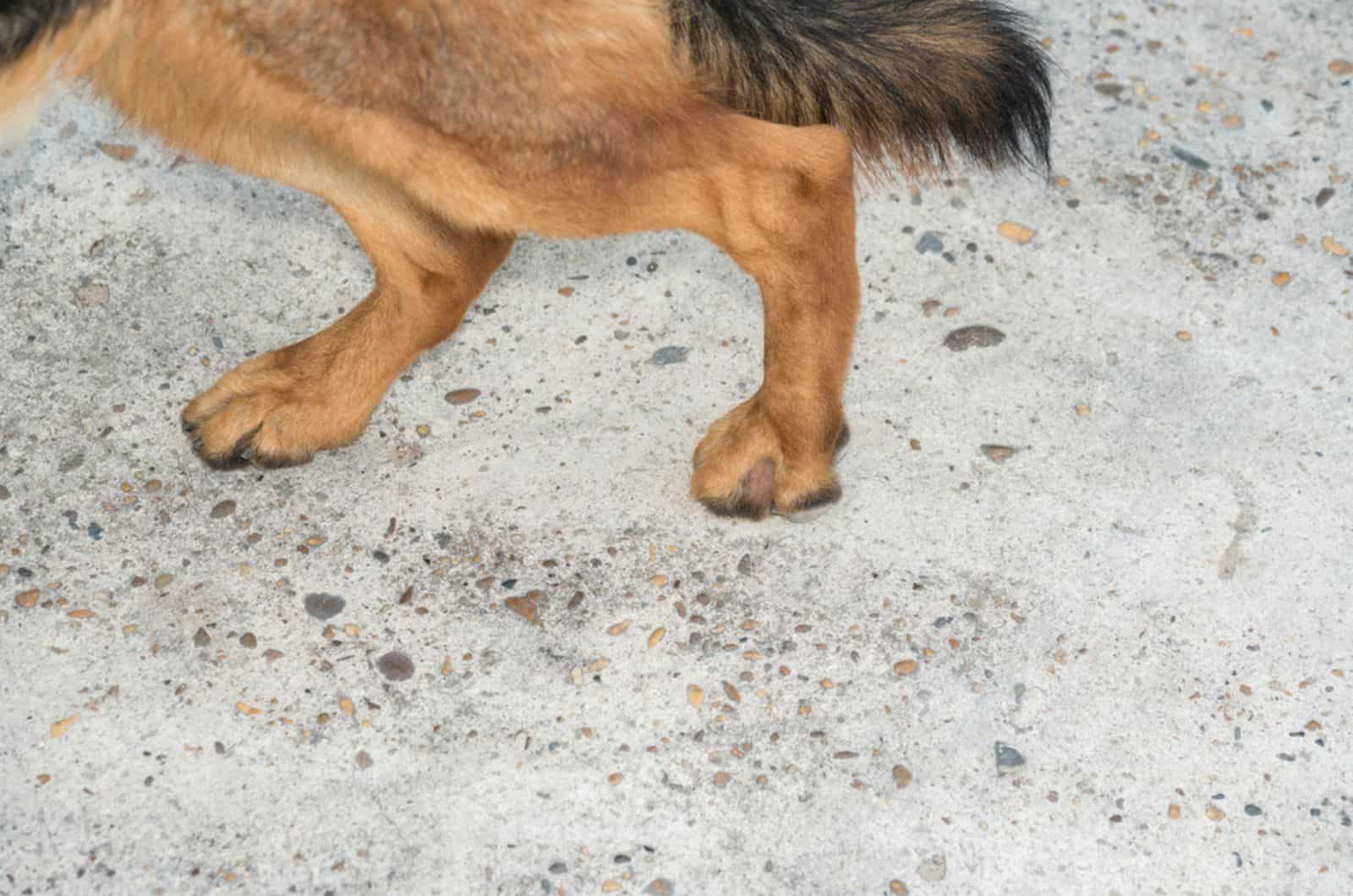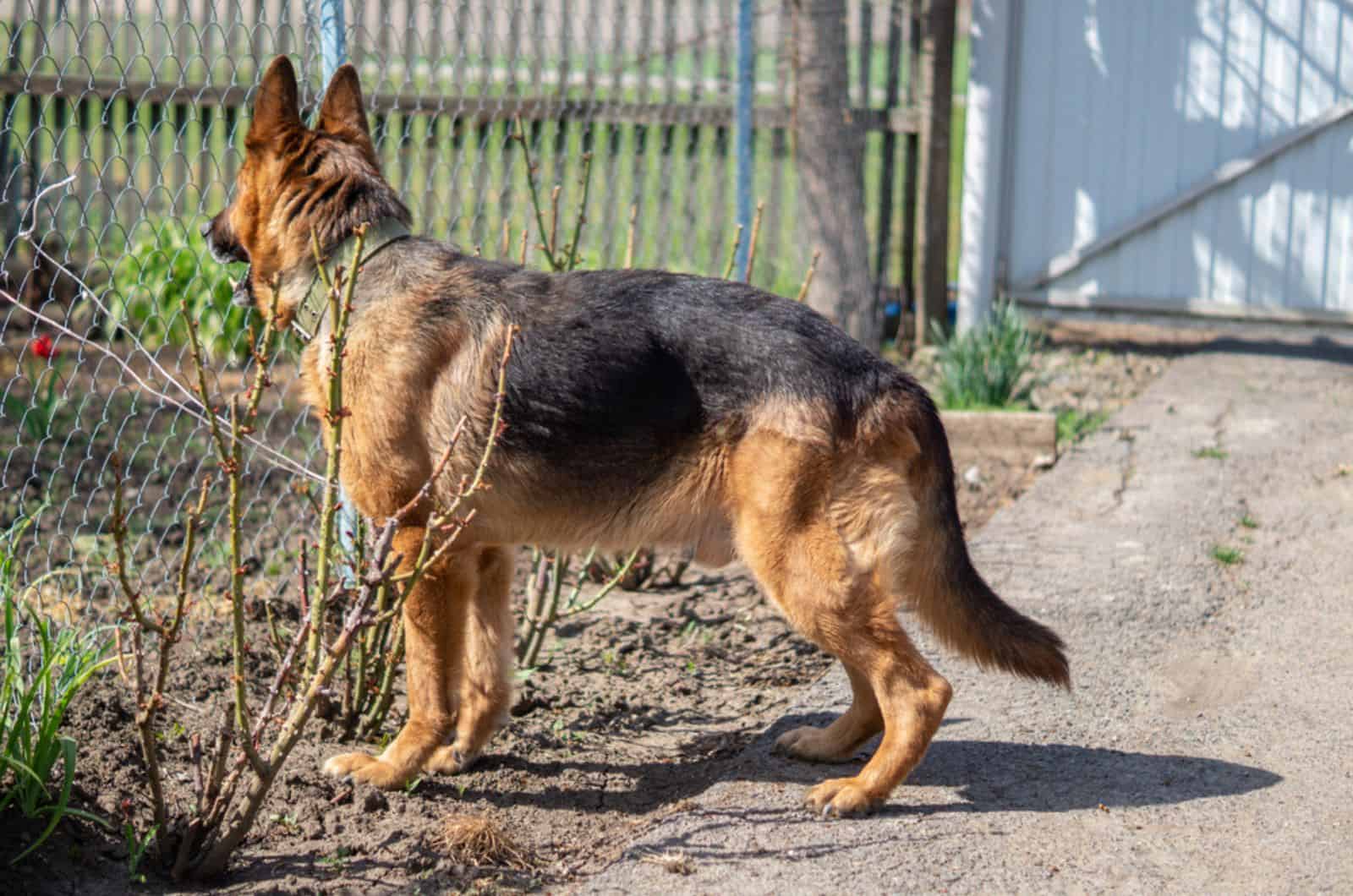If you are following the news about Crufts and are willing to see the other side of the show as well, you’ll notice a lot of alarming posts and hashtags.
People started to point out ridiculous conformation requirements for purebred dogs a long time ago, but it seems the real eye-opening video was shown in 2018.
It is a video of a German Shepherd with its back legs close together, and a sloped back that made the dog unable to walk properly.
You don’t have to be a dog breeder or a dog owner to know there is something seriously wrong with this poor dog. It is especially unnerving to watch it when it starts to run.
Now, this video (GSD Crufts) is an old video; however, it is not the last one.
Why is a GSD with its back legs close together a bad sign?
German Shepherd’s Back Legs Close Together

According to the American Kennel Club, the hind legs of a GSD should be: “both upper and lower thigh well muscled, forming as nearly as possible a right angle.”
The need to breed German Shepherds with such conformation led to the problem these dogs have today. For the sake of the show, they deliberately breed dogs with back legs close together so that they can reach that 90-degree angle.
This leads to dogs with serious movement problems, which is often called “hock movement”.
Here is an example: GSD puppy
Dogs are born with this issue, and in most cases, it can never be completely corrected. It also requires a lot of patience and vet trips, which are, at the same time, stressful for the dog and expensive for you.
Another name often used for this type of leg position is “cow hocks”.
Normal hind legs should be straight, without hock joints pointing inward or outward. However, the breed standards are getting in the way of a healthy dog’s looks.
Why Is It A Problem?

German Shepherds, both male and female, can have this problem. It is genetically inherited, and can further cause more health issues.
The problems won’t start to show up right away, but they will certainly progress if left untreated or if not treated in time.
The issues are:
- Pain
- Limited movement
- Painful movement
- Joint problems
- Hip dysplasia
On top of all this, you have to understand that a dog with these problems, and especially the constant pain, has a poor quality of life.
The German Shepherd is an active and affectionate dog that can turn aggressive, destructive, or completely opposite – depressed, if faced with pain every day.
The dog might not feel a lot of pain at the very beginning, but as the months go by, and the condition progresses, the pain will grow, too.
You will also notice your dog getting tired easily.
As we already mentioned, German Shepherds are not low-energy dogs that are born to lounge on the sofa.
These are active dogs that were bred to endure long working hours.
German Shepherds (or any other dogs) don’t deserve such a life.
How To Help A GSD With Back Legs Close Together
Just like with other health issues, the important step is to start early, when the dog is still a puppy and its growth hasn’t finished yet.
Here is the link to a GSD Growth chart to help you with the growth stages of a GSD.
If you notice any odd movement in your German Shepherd puppy, take him to the vet. A vet can do an X-ray of the hips and hind legs, as well as do a clinical examination of the dog to get a clear picture of what is happening.
The treatment includes:
- Exercise to build up muscles of the hind legs
- Knee braces
- Orthopedic beds
- Joint supplements
You can also help your dog if you give him well-balanced GSD food. German Shepherds are large dogs that need lots of protein to support the rapid growth and development of their muscular and joint systems.
Some people have tried swimming as an exercise for their German Shepherd puppies that have back legs close together.
Swimming is an activity that perfectly puts all of the back leg muscles into use, which ultimately leads to muscle build-up.
Stronger muscles help the dog move easier, support the joints, and make the cow hock look less obvious.
The Controversy

Dog shows and dog breed standards have been a topic of interest for many years. People realized that the way purebred dogs should look according to the standards is not the right way or the healthy way any dog should look.
The controversy does not just surround German Shepherds, but other dog breeds as well. For example, Goldendoodle Tail docking, Bulldog ear cropping, French Bulldog breathing problems, etc.
There is a movie called Pedigree dogs exposed, which was done by BBC one, that shows the dark side of Dog Shows, Pedigrees, and desired dog conformation.
There is also research done on this subject specifically focusing on the German Shepherds and their conformation breed standards.
There is also a blog from the creators of the mentioned movie that continues to tell the truth about these shows.
All of them have the same conclusion: breeding programs to fit the needs of Dog Shows must stop.
The sad truth is that the German Shepherd we talked about at the beginning won the Crufts that year. There are 7 types of GSDs, but the show-line dogs are the problem.
They are the ones that keep getting genetically butchered in order to make them “worthy of the show”.
If you think butchered is too strong of a word, take a look at the video one more time.
The Conclusion
If you have a German Shepherd with back legs close together, all of this might be too much for you. You didn’t know you were getting a puppy with this issue, and you don’t agree with the AKC and other Kennel Clubs’ opinions.
I understand you and the situation you’re in right now. The best you can do is treat your dog according to the vet’s instructions.
But, if you are a person who thinks that a German Shepherd should look like the dog that won the Crufts, I don’t think we have anything to talk about.
Unless you think it’s time to admit the problem and do something about it, then I’m all ears and ready to help you in the process.
Dogs are made to be our best friends, and to fully enjoy life without restrictions we made for them by manipulating their genes through various breeding programs.
This must stop today.















